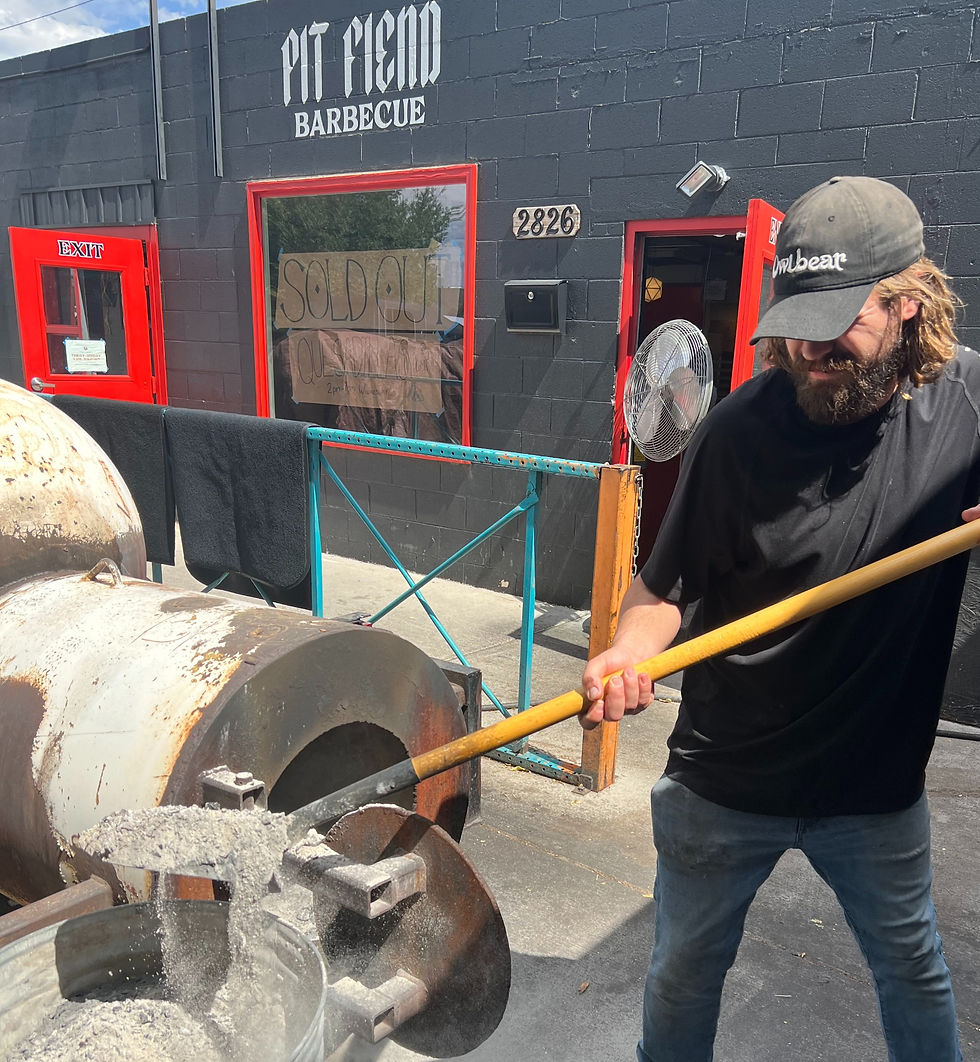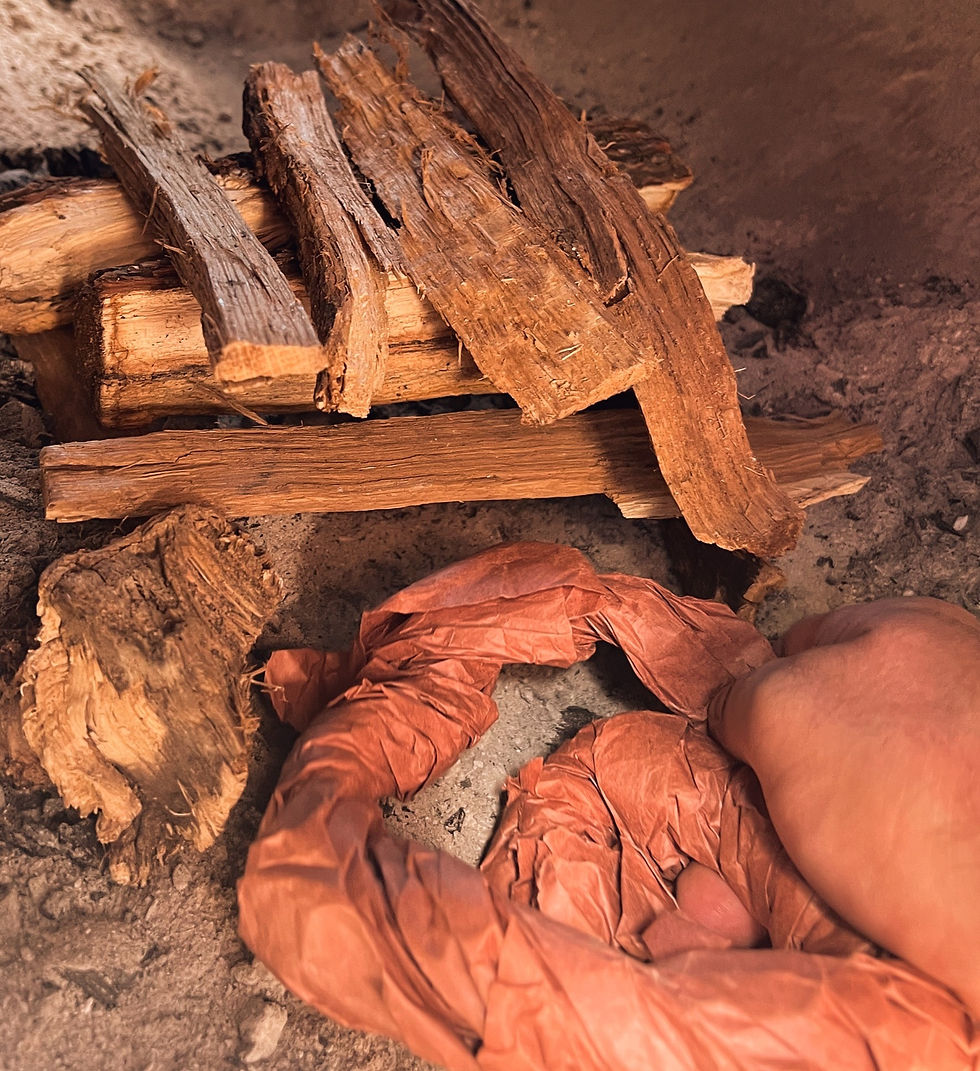Fire Maintenance
- Michael Graunke
- Aug 2, 2022
- 7 min read
From the first cook of the week to the end of Sunday service, the smokers at Pit Fiend Barbecue are always active. We start our fires more than 24 hours before the first slice of brisket is served, and maintain them carefully throughout the week as our needs change. Maintaining a hot, smoky fire for chicken is a different experience from the low-temp efficiency of a brisket fire, both of which stand opposed to the high temperatures and relatively “dirty” smoke of a holding fire, which we burn between cooks to maintain ambient internal temperatures when there is no food on the smoker.
Unlike most barbecue joints in Colorado, we smoke exclusively with whole oak logs. Most other professional pitmasters favor pellet smokers. They’re able to produce tender, juicy cuts even without the complete combustion of whole logs, but at the expense of that clean, delicious smoky flavor. Pellets sit in a heap, smoldering slowly with limited airflow, activated by an electric coil or other artificial heat source. The primary benefits to pellet smokers are consistency and predictability. While the end result may be lacking in flavor or quality, these smokers require far less fiddling during the course of the cook. Much like using a crock pot or pressure cooker to simplify a braising process, pellet smokers alleviate the need for close attention while producing a relatively consistent product every time.
Rotisserie smokers are another common crutch among Colorado pitmasters. These impressive machines rotate cuts of meat during the course of the cook as they rest upon massive grates that spin much like a ferris wheel. Similar to a pellet smoker, rotisserie smokers decrease the margin of error for inexperienced cooks by providing a more consistent, predictable outcome with less effort. They also provide better flavor than pellet smokers, provided they are built with an offset fire box equipped for whole logs. The complete combustion achieved by a rotisserie smoker offers a far superior smoke flavor to that of a pellet smoker, good enough to be practically indistinguishable from an offset rig. The greatest difference between an offset and a rotisserie is in the capacity for convection. This is important because convective heat is what produces the highly-sought “bark” on the exterior of large cuts like brisket - not quite crispy, not quite chewy, with a deep, rich flavor permeated by smoke.

Great barbecue means great bark, and nothing achieves perfect bark quite like an offset smoker. The first reason is that an offset is designed for optimal airflow, with smoke moving rapidly in a wave-like pattern through the smoking chamber as it is drawn upwards through the smoke stack by thermodynamic forces. The second reason is because of the acrid-tasting and potentially harmful particulate present in wood smoke. While trace amounts are responsible for the delicious smoke flavor associated with great barbecue, too much dirty smoke accumulating on the surface of the meat will have an adverse effect on flavor. The shape of a rotisserie smoker is designed for consistent temperatures at the expense of consistent convection. The result can be a smokier, bitter-tasting product contaminated by carcinogenic particles. Although the relatively inconsistent temperatures of an offset smoker make a pitmaster’s job more tedious, the experienced cooks at Pit Fiend Barbecue take great care to correct for these inconsistencies through diligent fire management to produce a superior product every time.

The task of tending fires begins even before flame first touches fuel. At the start of each week, we clean our fireboxes of last week’s ashes, allowing them to cool for several days before disposal. Next, we construct a starter fire with kindling, typically arranged in the classic shape of a log cabin. This format allows air to flow freely around each piece of wood, fueling young flames, while the compact nature of the design promotes efficiency by encouraging each twig of kindling to feed off the others around it, and creates hot spots at the juncture of multiple pieces of fuel where the fire’s momentum can withstand adverse conditions such as low ambient temperatures or inconsistent airflow. Finally, we add a coiled rope of butcher paper, scrunched and twisted into a compact disk with tons of internal surface area. The idea is to ignite the center of this coil, which will then spread quickly through the many nooks and crannies, elevating the ambient temperature to a point where the wood around it will ignite. We put this fire starter into the center of our kindling structure, somewhere near the bottom, and light from beneath. As the lighter ignites the paper, which then ignites the kindling, our fire quickly combusts and produces large, hot embers that encourage rapid ignition with minimal smoldering as we add increasingly larger logs to produce more heat.

The secret to clean smoke in an offset smoker is to maintain an efficient bed of embers. These embers are created when a log is fully combusting but has not yet exhausted its usable fuel on any surface. If the ambient temperature in the firebox is too low, a log will slowly burn from the outside inwards, leaving a dirty surface layer of ash that impacts smoke flavor and discourages further combustion by insulating the interior of the log. A hot, efficient fire allows a log to fully combust all at once, igniting quickly on multiple surfaces nearly as soon as it enters the fire box. After several minutes of exposure to this kind of heat, the entire log is burning all at once, inside and out. Several more minutes, and the structural integrity of the log has dissipated. At this point, the log is still outputting maximal heat energy, but can be easily broken down with the tip of a shovel to expose more surface area, thereby increasing the potential energy output. These huge, hot embers create a cyclical effect as whole logs are added on top - they burn so hot and efficiently that they quickly ignite each new piece of wood, self-perpetuating as the fire grows. This can pose problems as we strive to keep the internal temperature of the smoker from getting too hot for low-and-slow cooking, so for a Pit Fiend cook, the key to great barbecue is maintaining an appropriate bed of embers that promotes efficient combustion without excessively increasing temperatures.

The other major factor impacting efficient combustion is airflow. Embers may provide plenty of heat, but a fire also needs oxygen in order to thrive. When we first start a fire, we raise the doors of the smoker to create a wide-open space for air to move. That way, even if our initial fire structure is a bit tight, the excess of oxygen in the chamber helps maintain a high ambient temperature around the fuel source until it is able to ignite. While a fresh fire may smolder unpleasantly, irritating eyes and sinuses, the initial heavy output of dirty smoke indicates that multiple surfaces are exposed to freely flowing oxygen, promoting complete combustion once the temperature is high enough. Somewhat counterintuitively, having too much dirty smoke when starting a fire can be a good sign that air is moving effectively around the kindling and logs within the fire box.
Once the fire ignites, however, the smoldering should quickly cease. Logs that are burning efficiently - exposed equitably to heat and oxygen - do not smolder. If a log is putting out visibly dirty gray or white smoke, it is either not hot enough to combust, or it is not exposed to appropriate airflow. The lack of heat can be a result of the log’s density as the surface warms more quickly than the interior, causing ash to build up before the fuel fully ignites. It can also be a result of proximity to radiant heat if the embers and active combustion activity in the chamber are not close enough to fresh, uncombusted fuel. In either case, the solution is to turn, move, and adjust logs until the confluence of heat and airflow are sufficient to ignite the fuel source and combust completely. In the case of improper airflow, the prognosis is similar - move and adjust logs, creating channels around each piece of fuel and allowing the wood to “breathe”. But while insufficient heat is largely the result of fuel dispersion in the chamber (structures not compact enough to self-perpetuate and maintain temperature), insufficient airflow results when the pieces of fuel are too close together and “choke out” the fire by preventing the flow of oxygen from reaching the heat source or combustible new fuel. This is one of the major drawbacks of pellet smokers, which rely on a heap of wood chunks undergoing incomplete combustion to produce acrid smoke.

In terms of fire management, the result every good pitmaster strives to achieve is referred to as “blue smoke” - when the output from the smoke stack is nearly transparent with a slightly blue tinge, and causes the air behind it to appear to ripple like asphalt on a hot summer’s day. The absence of color indicates the absence of harmful, foul-tasting particulate that might settle upon the surface of the meat, interfering with the development of delicious bark. Blue smoke is a sign of a clean, efficient fire in which the fuel source is equitably exposed to both appropriate heat and sufficient airflow. Over 90% of the smoke flavor in barbecue comes from the smoke vapor, which consists of microparticles suspended in evaporated water. Unlike dirty, visible smoke that contains carcinogenic particles of incompletely combusted carbon, the smoke vapor in blue smoke is nearly invisible and effectively harmless for human consumption. If it were any “cleaner”, there would be no smoke at all. But although you won’t be able to see the smoke at Pit Fiend Barbecue, you will be able to taste it, and that is always the main objective when we incorporate smoke into food. Whether we’re cooking spare ribs or swordfish, we promise you’ll always be able to taste the meat, and the heat.
Comments